Never-Ending Battles Between God Ra And Indestructible Apophis In Ancient Egyptian Beliefs
A. Sutherland - AncientPages.com - Unlike mythologies from other ancient cultures, Egyptian mythology does not have many terrible creatures. The most frightening monster was a gigantic and evil snake, Apophis (in Greek), while in Egypt, it was known as Apep.
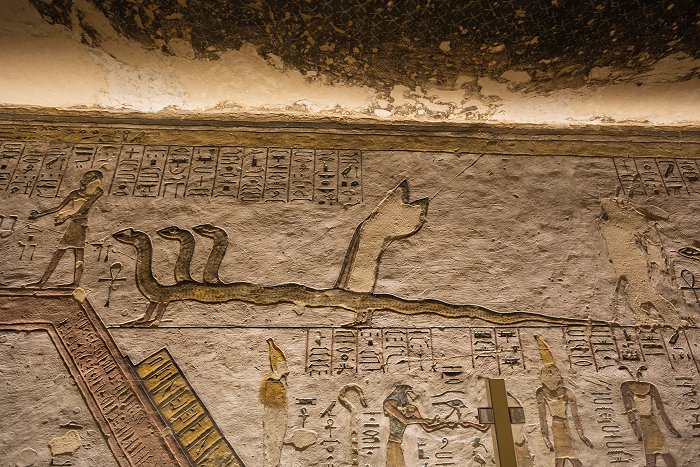 Apophis in the tomb of Ramesses III. Credit: Adobe Stock - Vermeulen-Perdaen
Apophis in the tomb of Ramesses III. Credit: Adobe Stock - Vermeulen-Perdaen
The snake represented a source of chaos and darkness, and as such, he was frequently portrayed as the enemy of Ra on tomb walls and in funerary papyri.
As the one who was always in battle with the god Ra, Apophis is also mentioned in ancient tales, particularly widespread during the New Kingdom (c. 1550 BC – c. 1077 BC).
Ancient storytellers narrated that the snake lurked below the horizon daily, waiting for Ra in different locations. One of them was a western mountain called Bakhu.
In his book "Ancient Egypt, the Light of the World," Gerald Massey writes that "Mount Bakhu having been named in Egyptian from the olive-tree of dawn as a celestial summit located in Olivet [Biblical: Mount of Olives], the mountain eastward; and in the Gospels, although the mount is mentioned several times, and apparently in different localities, there is but one name given to it, that of Mount Olivet=Bakhu, one typical mount – the Egyptian mount, equivalent to the horizon, as the summit of the earth."
Among Apophis's other hiding places was the so-called "Tenth Region of the Night," from which he wanted to attack Ra just before dawn when the sun god was on his way to begin his daily journey across the sky. Apophis's different hiding places gave him the name "World-Encircler."
Prayers, Spells, And Good Will Supported Ra's Fight With Apophis
According to tradition, Ra's victory each night over Apophis was supported by prayers of the priests and worshipers, who felt obligated to help Ra successfully leave the underworld and appear as usual each morning to bring light and life to the Egyptians. Additionally, the Egyptians practiced several proper spells and rituals that were believed to ward off the evil snake and help Ra continue his crucial journey across the sky.
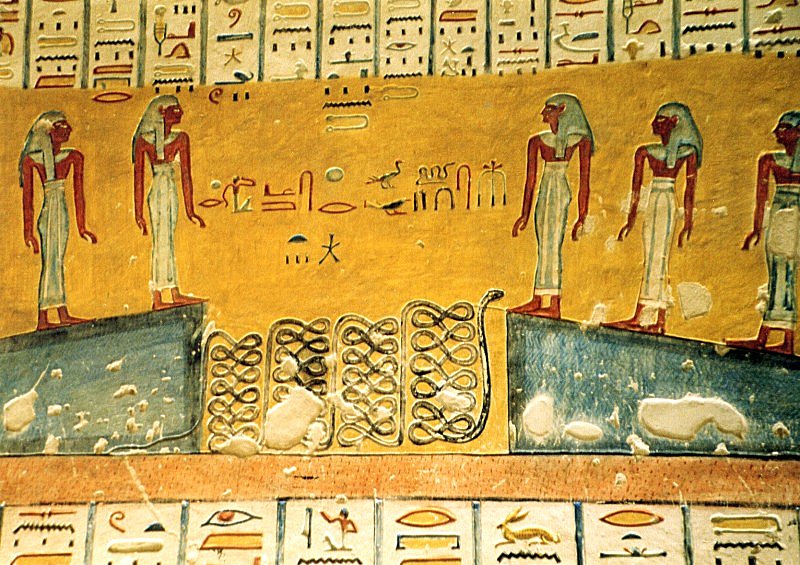 Apophis in his realm – Duat. A part of a scene of the fourth hour of the Book of the Gates from KV2, tomb of Rameses IV. Analysis: "the time is like a serpent, of which the nocturnal hours are born like goddesses. After its trip they are devoured again by the serpent. The blue triangles represent the water in the underworld". Image credit - contrib. - Schreibkraft - CC0 1.0
Apophis in his realm – Duat. A part of a scene of the fourth hour of the Book of the Gates from KV2, tomb of Rameses IV. Analysis: "the time is like a serpent, of which the nocturnal hours are born like goddesses. After its trip they are devoured again by the serpent. The blue triangles represent the water in the underworld". Image credit - contrib. - Schreibkraft - CC0 1.0
The Egyptians used to build wax figures of the snake, which they then disfigured and dismembered. One ritual included the depiction of Apophis, whose symbolical destruction was equal to the destruction of the enemy. This ritual was supposed to give the gods a particular advantage against Apophis.
Hostility Of Apophis Against God Ra
Legend has it Neith was a fearsome Egyptian mother of the gods and creator of Ra, Apophis, and the universe. The story of Apophis's birth was recorded in the second century BC on the walls of Esna Temple, located about 50 km south of Luxor (ancient Thebes). At this very moment when the sun god Ra appeared, the sinister Apophis was also born. According to the concept of duality, evil is necessary as a counterpart to good.
Ra ruled over sunny days, crossing the sky daily in his solar barque accompanied by gods and the dead pharaohs. He traveled through the afterlife by night, a dangerous abode of the great serpent Apophis, whose time and place of action were just there.
During his journey through the underworld, the sun god Ra fought demons, which was unusual because according to the principle of Maat, or order against chaos represented by monsters, this struggle had to happen.
Each Night The Same Battle
So, the indestructible Apophis attempted to end Ra's existence and his rule each night. Occasionally, during cloudy, darker days and eclipses, the ancient Egyptians believed that Apophis was very close to defeating Ra.
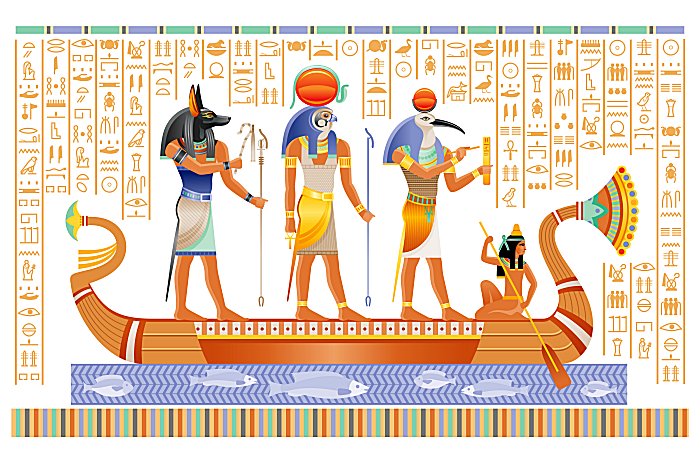 Egyptian papyrus with gods in boat. Anubis, Ra, Thoth, ancient Egyptian deities. Credit Adobe stock -Olga Che.
Egyptian papyrus with gods in boat. Anubis, Ra, Thoth, ancient Egyptian deities. Credit Adobe stock -Olga Che.
They were wrong because the actual fight between these two eternal enemies occurred only during the night. As Ra's barque disappeared from the sky, Apophis and many demons waited patiently at the underworld gates to attack. Fortunately, Ra had many helpers on his boat who were ready to act. Without their assistance, the rising daily sun and the world's existence were seriously in danger.
This battle, over and over again, could never end. Until the next night, Ra could feel protected and reborn to return the next night and confront the next fight.
First Defeat Of Apophis By Ra
Apop was first defeated by the god Ra, who took the form of a giant cat for this purpose, then subdued and removed from the world's borders by Seth, who used to help fight the monster at the request of the god Ra.
Using spells, Seth pierced the body of a monstrous snake with spears, but it never helped because the monster regenerated and still posed a threat.
In "The Book of the Dead," there is a prophecy:
"This earth will return to the primeval water, Nun, to the endless flood as it was in the beginning. And in the end, there will be no gods or goddesses. Nothing but Atum, the Lord of All who made all mankind and all gods."
Atum was destined to appear as a serpent.
Written by – A. Sutherland - AncientPages.com Senior Staff Writer
Updated on February 25, 2024
Copyright © AncientPages.com All rights reserved. This material may not be published, broadcast, rewritten or redistributed in whole or part without the express written permission of AncientPages.com
Expand for referencesReferences:
A comprehensive List of Gods and Goddesses of Ancient Egypt
Clayton, Matt, Egyptian Mythology
More From Ancient Pages
-
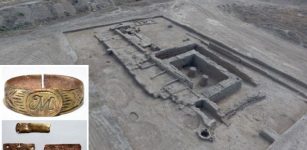 Stunning Ancient Khanqah With Large Underground Crypt, Ritual Halls And Burials Discovered In Turkestan
Archaeology | Aug 14, 2020
Stunning Ancient Khanqah With Large Underground Crypt, Ritual Halls And Burials Discovered In Turkestan
Archaeology | Aug 14, 2020 -
 Controversial Ruler Tsar Boris Godunov’s Exact Date Of Birth Determined By Scientists
Archaeology | Aug 31, 2021
Controversial Ruler Tsar Boris Godunov’s Exact Date Of Birth Determined By Scientists
Archaeology | Aug 31, 2021 -
 Traces Of Ancient Near East Civilization In America – An Out-Of-Place Ancient Inscription – Part 2
Civilizations | Nov 13, 2020
Traces Of Ancient Near East Civilization In America – An Out-Of-Place Ancient Inscription – Part 2
Civilizations | Nov 13, 2020 -
 Shipboard Cannon Found On The Swedish West Coast May Be Europe’s Oldest!
Archaeology | Sep 12, 2023
Shipboard Cannon Found On The Swedish West Coast May Be Europe’s Oldest!
Archaeology | Sep 12, 2023 -
 Early Humans In Europe Were Making Fires At Least 250,000 Years Ago – New Study
Archaeology | May 18, 2023
Early Humans In Europe Were Making Fires At Least 250,000 Years Ago – New Study
Archaeology | May 18, 2023 -
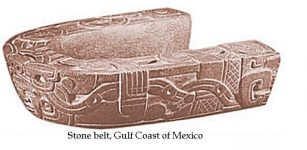 Millennia Old Ceremonial Stone Belt And Maya Pok-A-Tok Ball Game
Ancient Traditions And Customs | Nov 28, 2017
Millennia Old Ceremonial Stone Belt And Maya Pok-A-Tok Ball Game
Ancient Traditions And Customs | Nov 28, 2017 -
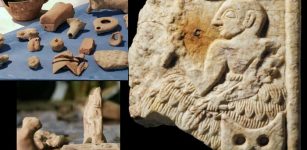 Hundreds Of Thousands Of Sumerian Artifacts Have Been Stolen From Iraq’s Museums And Archaeological Sites
Artifacts | Dec 7, 2020
Hundreds Of Thousands Of Sumerian Artifacts Have Been Stolen From Iraq’s Museums And Archaeological Sites
Artifacts | Dec 7, 2020 -
 Tiny Tools And Skills Of Mysterious Toaleans People In Southernmost Sulawesi, Indonesia
Archaeology | May 27, 2021
Tiny Tools And Skills Of Mysterious Toaleans People In Southernmost Sulawesi, Indonesia
Archaeology | May 27, 2021 -
 Unique Life-Sized Camel Carvings In Northern Arabia Are Much Older Than Previously Thought
Archaeology | Sep 15, 2021
Unique Life-Sized Camel Carvings In Northern Arabia Are Much Older Than Previously Thought
Archaeology | Sep 15, 2021 -
 Sir Francis Walsingham: Spymaster, Politician And Trusted Adviser To Queen Elizabeth I
Featured Stories | Nov 25, 2019
Sir Francis Walsingham: Spymaster, Politician And Trusted Adviser To Queen Elizabeth I
Featured Stories | Nov 25, 2019 -
 What Ancient Dung Reveals About Epipaleolithic Animal Tending
Archaeology | Sep 15, 2022
What Ancient Dung Reveals About Epipaleolithic Animal Tending
Archaeology | Sep 15, 2022 -
 Maat – Ancient Egypt’s Most Important Religious Concept
Egyptian Mythology | Apr 4, 2018
Maat – Ancient Egypt’s Most Important Religious Concept
Egyptian Mythology | Apr 4, 2018 -
 Kikimora – Nightly Evil Female Spirit And Goddess Of Chickens In Slavic Beliefs
Featured Stories | Oct 22, 2018
Kikimora – Nightly Evil Female Spirit And Goddess Of Chickens In Slavic Beliefs
Featured Stories | Oct 22, 2018 -
 Hydra Greek Monster: Fearsome Multi-Headed Dragon That Inhabited Swamps Of Lerna
Featured Stories | Sep 20, 2019
Hydra Greek Monster: Fearsome Multi-Headed Dragon That Inhabited Swamps Of Lerna
Featured Stories | Sep 20, 2019 -
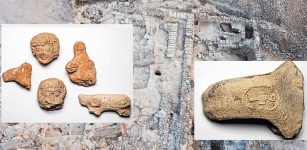 Kingdom Of Judah: Government Complex And 120 Seal Impressions Stamped On Jars – Unearthed
Archaeology | Jul 23, 2020
Kingdom Of Judah: Government Complex And 120 Seal Impressions Stamped On Jars – Unearthed
Archaeology | Jul 23, 2020 -
 Fantastic Discovery At Hadrian’s Wall Reported By Archaeologists
Archaeology | Sep 10, 2022
Fantastic Discovery At Hadrian’s Wall Reported By Archaeologists
Archaeology | Sep 10, 2022 -
 Curious Ice Age Figurine Of Unidentified Animal Species Puzzles Scientists
Archaeology | Jul 31, 2023
Curious Ice Age Figurine Of Unidentified Animal Species Puzzles Scientists
Archaeology | Jul 31, 2023 -
 Nihansan And Bricriu: Unpredictable Tricksters Who Fool Others And Are Fooled Themselves
Featured Stories | May 11, 2024
Nihansan And Bricriu: Unpredictable Tricksters Who Fool Others And Are Fooled Themselves
Featured Stories | May 11, 2024 -
 Mystery Of Panxian Cave: How Could Gigantic Animals Reach A Mountain Cave Located Over 1600m Above Sea Level?
Featured Stories | Jul 1, 2014
Mystery Of Panxian Cave: How Could Gigantic Animals Reach A Mountain Cave Located Over 1600m Above Sea Level?
Featured Stories | Jul 1, 2014 -
 Mystery Of The Demon Wall In Sauherad Church Finally Solved
Archaeology | Dec 15, 2021
Mystery Of The Demon Wall In Sauherad Church Finally Solved
Archaeology | Dec 15, 2021
